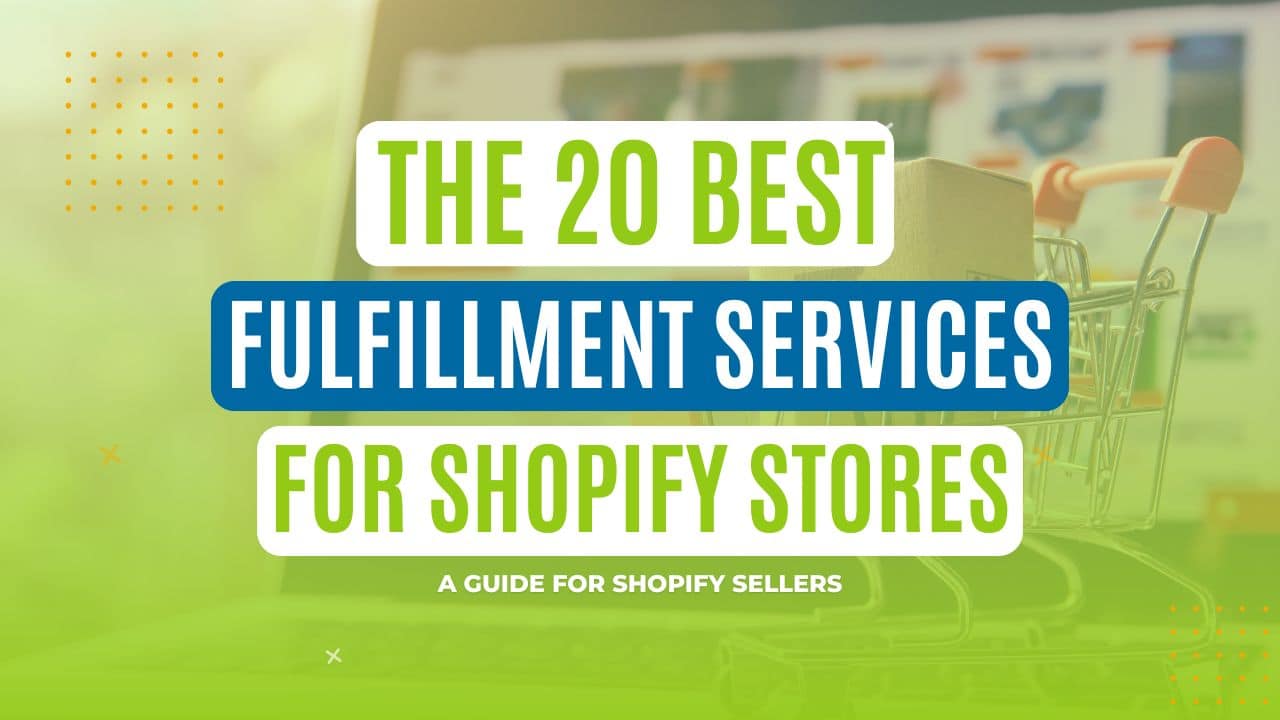
Jump right in: The Top 20 Best Fulfillment Services for Shopify
Running a successful Shopify store means not only selling great products but also delivering them quickly and reliably to your customers. As your business grows, outsourcing order fulfillment to a third-party logistics (3PL) provider can save time, reduce shipping costs, and keep customers happy. In this article, we break down the 20 best fulfillment services for Shopify sellers in the U.S., from small startups to high-volume enterprises. We’ll explore what each fulfillment company offers, their pricing (rated $ to $$$$), warehouse locations, and any special services (like subscription-box or kitting support). Our top pick is eFulfillment Service, thanks to its all-around value for Shopify merchants, but each of these 3PLs has unique strengths.
Fulfillment Services for Shopify Compared
Below is a quick comparison table for a snapshot of each fulfillment service, followed by detailed sections on each provider. We’ll also cover tips on choosing the right fulfillment partner and answer common FAQs for Shopify store owners.
(Price Range: $ = lowest cost, $$$$ = highest cost. “Best For” indicates the ideal scenario or merchant type for that provider.)
1. eFulfillment Service – Best Overall for Shopify Sellers
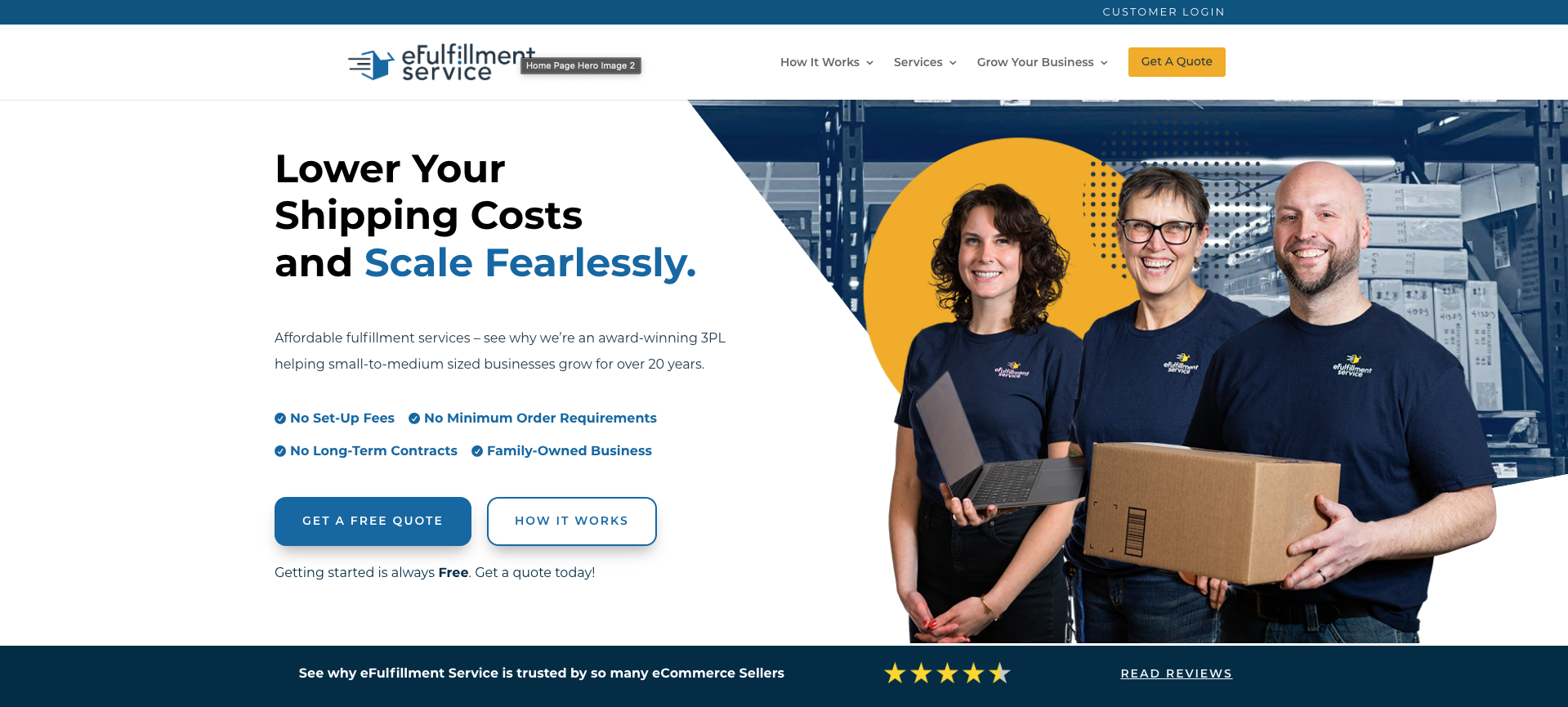
eFulfillment Service is our top pick for Shopify fulfillment due to its balanced offering of affordability, flexibility, and experience. Founded over 20 years ago, this family-owned 3PL has been providing award-winning fulfillment services for small-to-medium eCommerce businesses. They pride themselves on transparent pricing with no setup fees, no long-term contracts, and no order minimums. eFulfillment Service integrates with 40+ shopping carts and marketplaces (including Shopify) for free, making it simple to sync your orders. With a 99.9% order accuracy rate, they have a strong reputation for reliability.
Why We Picked eFulfillment Service: For Shopify sellers of any size, eFulfillment Service offers an excellent all-around solution. Its transparent, no-surprise pricing and lack of minimums lower the barrier for small shops to outsource fulfillment. At the same time, its reliable service and ability to scale make it suitable for larger stores too. The company has decades of experience and a track record of happy clients. While it operates only one U.S. warehouse, eFulfillment Service compensates with efficiency and personalized service. If you value cost savings, simplicity, and trustworthiness, this 3PL is hard to beat as the best overall fulfillment service for Shopify stores.
Managing inventory doesn’t have to be a hassle.
Partnering with a 3PL like eFulfillment Service means you can focus on growing your business while we handle the details. Request a Free Quote Today!
2. ShipBob – Best for Fast Shipping & Scalability
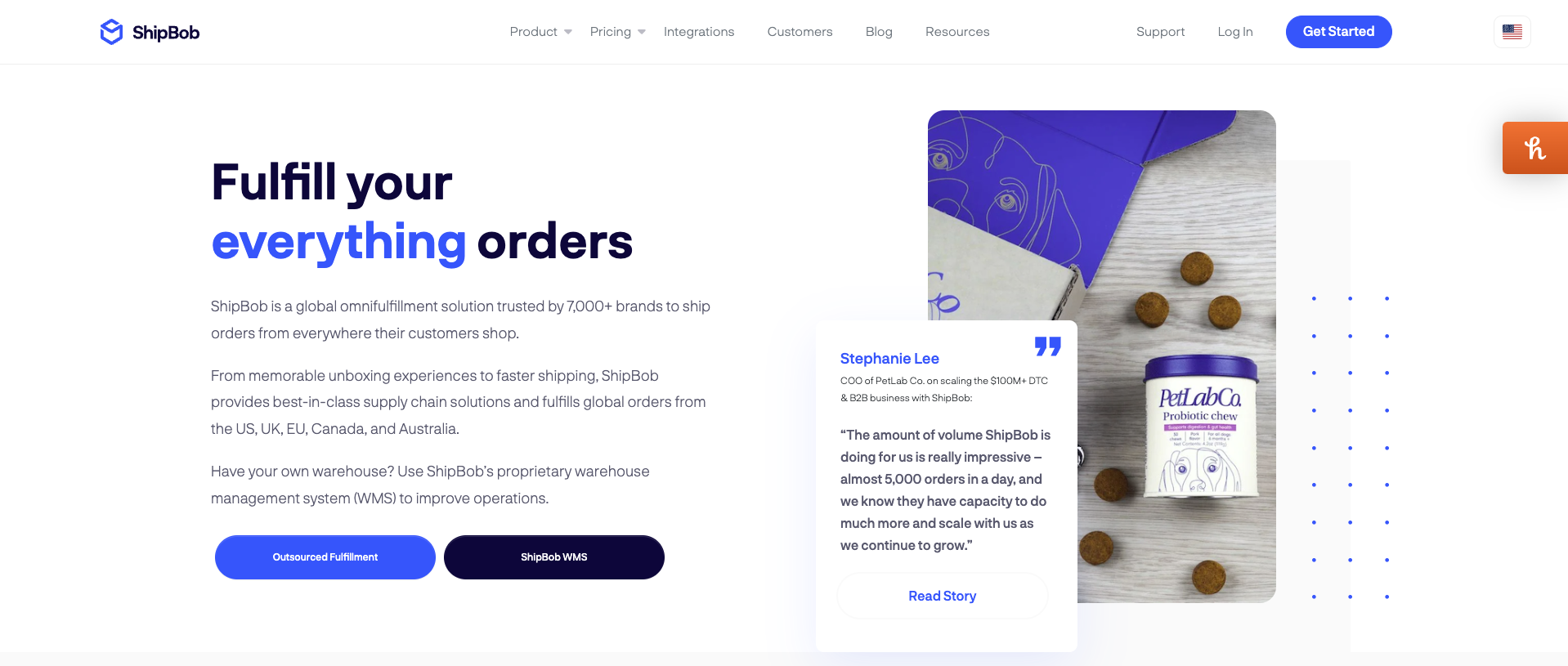
ShipBob is a big name in eCommerce fulfillment and an especially strong choice for Shopify merchants who prioritize fast shipping and easy scaling of their operations. Founded in 2014, ShipBob has rapidly grown into a 3PL with anetwork of 50+ fulfillment centers across the United States (and expanding internationally). They seamlessly integrate with Shopify. ShipBob boasts a 99.95% order accuracy rate, ensuring customers get the right products on time.
|
ShipBob at a Glance |
Details |
|
Best for |
Shopify sellers looking for fast shipping options and an easily scalable fulfillment solution. Mid-size and larger brands that are expanding domestically or globally will benefit most. |
|
Pricing |
$$ – Moderate, volume-based pricing. Example costs: ~$5/month per bin storage, pick+pack ~$0.20–$0.30 per item plus shipping. $275 monthly minimum applies, so micro-sellers may find it pricey. |
|
Warehouse Network |
50+ warehouses (USA in all regions; also in Canada, EU, UK, Australia). You choose which warehouses to stock. This network enables fast shipping to most U.S. customers. International fulfillment available (useful if you have global Shopify stores). |
|
Notable Features |
– Shopify Integration: Robust and seamless; auto-sync orders and tracking. – Speed: 2-Day Express Shipping program and same-day order processing in many centers. – Tech Platform: Advanced dashboard with real-time inventory, analytics, and order management. – Customization: Offers custom packaging, branded inserts, and kitting so you can maintain brand experience. – Customer Support: Reputation for responsive support and dedicated reps for larger accounts. |
Why ShipBob stands out: ShipBob has become one of the top fulfillment choices for Shopify merchants by combining logistics efficiency with user-friendly tech. If your goal is to offer Amazon-level shipping speeds (like 2-day delivery) on your Shopify store, ShipBob is a strong contender. The ability to tap into multiple warehouses and its high order accuracy (99.95%) means you can keep customers happy across the country. Additionally, the centralized software and integration simplify operations – you won’t spend time manually pushing orders or updating tracking. For rapidly growing eCommerce brands, ShipBob scales alongside you; many merchants report smooth experiences expanding into new markets using ShipBob’s network.
Keep in Mind: ShipBob’s comprehensive service can be a bit pricier for very small sellers, since you need to meet minimum usage or else pay for unused capacity. Also, getting detailed quotes can require providing your product catalog and order estimates, as costs depend on factors like SKU dimensions and destinations. Overall, though, if your volume is growing and you need a reliable 3PL to handle fast shipping, ShipBob is one of the best in the business.
3. Red Stag Fulfillment – Best for Heavy or High-Value Products
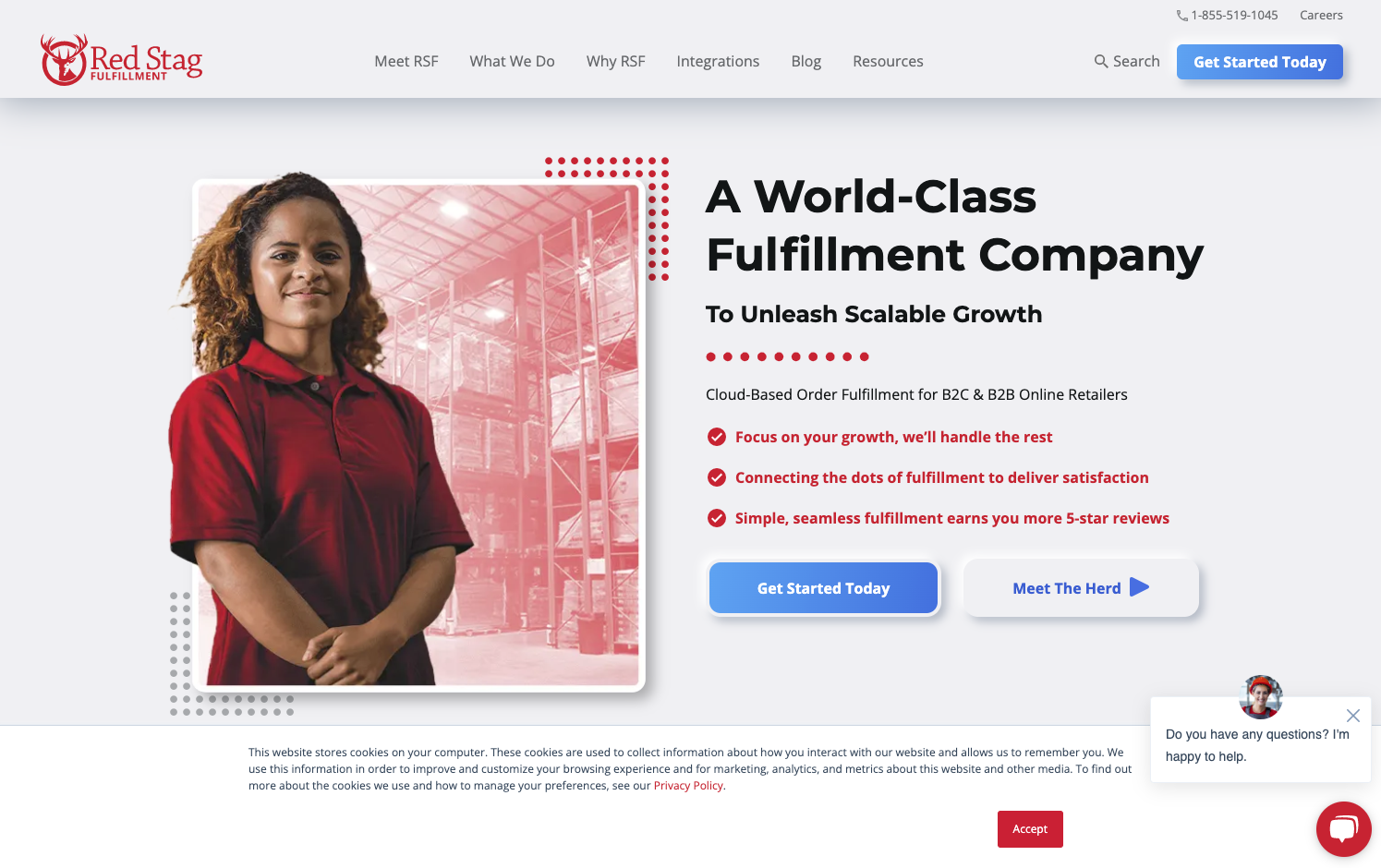
Red Stag Fulfillment is a top-tier U.S. 3PL that carved out a strong niche: handling bulky, heavy, high-value, or fragile products with exceptional care. If your Shopify store fulfills items that are large (think furniture, gym equipment), heavy (free weights, batteries), expensive (electronics, luxury goods), or need extra careful handling (fragile decor, glassware), Red Stag is often cited as the fulfillment service to trust. They were founded by eCommerce entrepreneurs who were dissatisfied with other 3PLs’ handling of their own heavy products, so they built Red Stag with an emphasis on accuracy, security, and customer service.
|
Red Stag Fulfillment |
Details |
|
Best for |
Shopify sellers of large, heavy, high-value, or fragile products who need a 3PL that can handle these items with care and precision. Examples: furniture, televisions, musical instruments, workout equipment, artwork, etc. Also ideal if you need near-perfect accuracy and are willing to pay a premium for peace of mind. |
|
Pricing |
$$$$ – Premium custom pricing. Expect higher-than-average fulfillment fees due to special handling. Storage often by pallet (if you sell big items, pallet storage is efficient). No setup fees but likely a monthly minimum volume. Red Stag often compensates clients if they make a mistake, reflecting confidence in their service. Budget accordingly for quality. |
|
Unique Features |
– 100% Accuracy Guarantee: They guarantee orders go out correct and on-time, or they pay you (e.g., they’ll cover the shipment cost or even the order value in some cases). – Security: High security warehouses (video surveillance, staff vetting) to prevent theft – important for expensive goods. – Special Handling: Trained staff and equipment for heavy/fragile items (no “one size fits all” packing; they use appropriate materials and methods). – Technology: Integrates with Shopify easily; provides real-time stock levels, and reports tailored to inventory turn for large products. |
|
Warehouse Locations |
2 warehouses (Knoxville, TN and Salt Lake City, UT in the USA). This bi-coastal approach allows 1-2 day ground shipping to most U.S. destinations. Climate-controlled storage available for sensitive items. Having fewer warehouses means consistent procedures and quality control, at the cost of maybe slightly longer shipping to some areas (but generally it’s optimized). |
Why Red Stag is worth it for the right merchants: If your Shopify store’s reputation hinges on delivering bulky or expensive items without a hitch, Red Stag’s focus is exactly that. Their clients often ship products where a single item might be worth hundreds or thousands of dollars, so mistakes are very costly. Red Stag’s operation is built to minimize errors, prevent damage, and handle complexity (like freight shipments or needing two people to lift an item) that typical eCommerce fulfillment centers may struggle with.
The fact that they offer guarantees and will take financial responsibility if something goes wrong is a huge vote of confidence – you won’t find many 3PLs willing to do that. Additionally, their knowledge of shipping heavy items can save you money; for example, they might use FedEx Home Delivery for a 100 lb item in a way that avoids surcharges or use custom boxing that lowers dimensional weight. They often catch things like “this product needs extra padding” before issues occur.
Considerations: Red Stag’s premium nature means it’s probably overkill if you sell typical small or lightweight items – those sellers can use cheaper options. Also, with only two warehouses, extremely time-sensitive shipments to far corners might sometimes go 3 days ground instead of 2 days; but in practice their coverage is fine for most. Onboarding with Red Stag might take a bit longer because they’ll really analyze your product requirements (which is good, but it’s a thorough process).
Lastly, they are U.S.-focused. If you need international fulfillment, Red Stag isn’t as strong in that – you’d likely use them for U.S. orders and another partner for overseas, since they do domestic U.S. exceedingly well. In summary, for what they specialize in, Red Stag is arguably the best in that class, making them an excellent choice for Shopify merchants with challenging fulfillment needs.
Stay Ahead of Your Competitors!
From inventory strategies to real-time tracking, eFulfillment Service ensures your products are always picked, packed, and shipped on time. Get a Free Quote today!
4. ShipMonk – Best for Subscription Boxes & SMB Growth
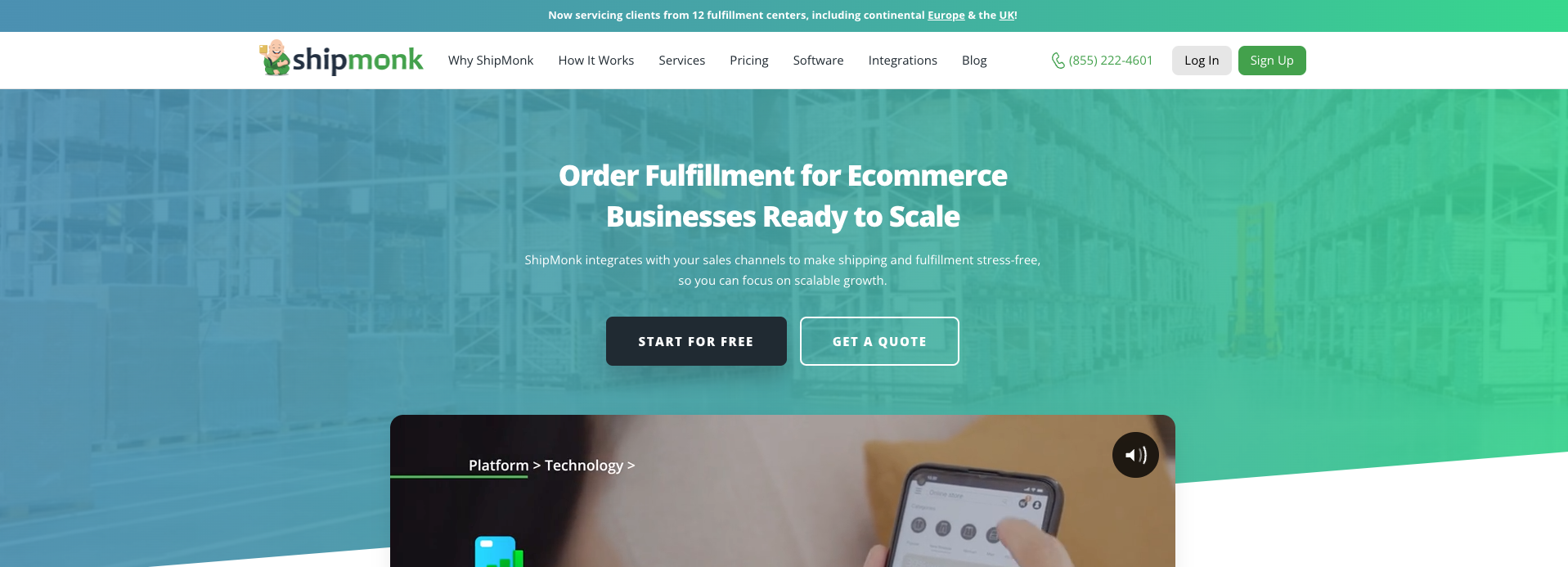
ShipMonk has a clear mission for entrepreneurs: “Stress less and grow more.” It specializes in helping businesses manage their fulfillment as they scale up. ShipMonk is an ideal choice if your Shopify storehas a diverse product catalog, because they offer highly flexible solutions and customizations. From its start in 2015, ShipMonk has grown rapidly; today they fulfill 100,000+ orders daily and integrate with many marketplaces and shopping carts, showcasing their technological prowess and capacity.
|
ShipMonk at a Glance |
Details |
|
Best for |
Shopify merchants who need flexible, customizable fulfillment – especially those running subscription box services, crowdfunding campaigns, or rapidly growing product lines. Great for startups graduating from in-house fulfillment to a 3PL. |
|
Pricing |
$$ – Expect slightly higher fees if you require special handling or during peak season (common with 3PLs). |
|
Warehouse Network |
Multiple warehouses in USA (FL, CA, PA, NV, TX) and international (Canada, UK/EU, Mexico). This enables efficient global fulfillment. You can stock inventory in all or selected warehouses; their system will route orders to the nearest location. |
|
Special Services |
– Subscription Box Fulfillment: Yes, expertise in recurring orders (can group monthly shipments, handle custom curation). – Crowdfunding Fulfillment: Yes, experience with one-time large batch shipments for Kickstarter/Indiegogo backers. – Custom Packaging: Yes, offers branded packaging, inserts, custom labeling. – Kitting & Assembly: Yes, can assemble kits or bundles as separate SKUs. – Integration: Supports 75+ platforms (e.g., Shopify, Amazon, Walmart, Etsy) for multichannel sellers. |
Why Shopify sellers like ShipMonk: The combination of friendly technology, no minimum commitment, and specialty services makes ShipMonk very appealing for small-to-medium Shopify businesses. If you run a subscription box, for instance, ShipMonk understands how to kit items for a monthly box and ship them all at once – a complex task that not all 3PLs handle gracefully. Similarly, if you’re a startup that just had a successful crowdfunding campaign, ShipMonk can import your hundreds or thousands of pre-orders and efficiently get them out the door. They also scale with you: many merchants stick with ShipMonk from just 100 orders a month to 10,000+ orders, increasing warehouse nodes and services as needed.
Keep in Mind: ShipMonk’s vast capabilities come with a lot of options, which can feel overwhelming at first. The dashboard offers many settings and the initial setup/integration may take some time to get fully comfortable. Additionally, while costs are reasonable, having a large number of SKUs or very complex products might incur higher management fees – e.g., more storage space, more intricate picking processes (they do handle it, but it’s something to budget for). Overall, for most Shopify sellers aiming to grow, ShipMonk strikes a great balance between flexibility and affordability.
5. Shopify Fulfillment Network – Best Seamless Shopify Integration
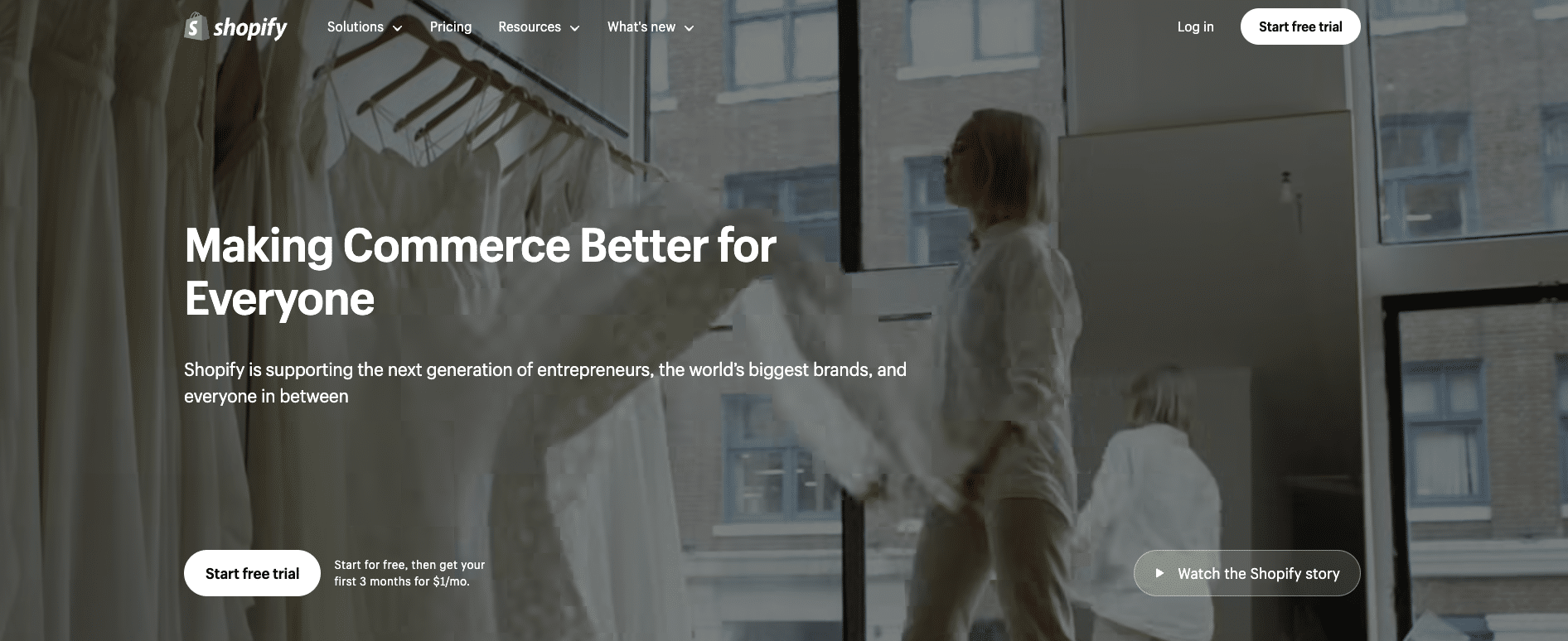
Shopify Fulfillment Network (SFN) is Shopify’s in-house fulfillment solution designed to give store owners a hassle-free, integrated logistics option. If you want something built into your Shopify admin with minimal third-party tools, SFN is the go-to. It offers a network of warehouses across the United States (and Canada) and promises fast shipping to 99% of the U.S. population once your inventory is distributed in their system. SFN was bolstered by Shopify’s 2022 acquisition of Deliverr and a partnership with Flexport, leveraging advanced tech for demand forecasting and inventory placement.
|
Shopify Fulfillment Network (SFN) |
Details |
|
Best for |
Shopify store owners who want a native fulfillment solution with minimal setup and tight integration. Ideal for U.S.-based businesses meeting the order volume criteria (roughly 3–200 orders/day), and those who value simplicity over heavy customization. Great for new Shopify merchants who want to outsource fulfillment without juggling a separate 3PL dashboard. |
|
Pricing |
$$ – Variable per order. No upfront fees, you pay for storage + fulfillment. Costs depend on item size/weight and shipping distance. Example: ~$5 to ship a small, light item domestically. Returns are included. Generally competitive rates due to Shopify’s volume leverage, but ensure your product mix fits their cost structure. |
|
Network & Speed |
Warehouses across U.S. & Canada. Inventory is auto-distributed for 2-day or 3-day delivery to most of U.S.shopify.com. You send inventory to one location and SFN moves it behind the scenes. Delivery promise is fast (comparable to Prime in many cases). |
|
Integration |
Seamless – built into Shopify. Orders are automatically fulfilled and tracking sent to customers. You manage everything in your Shopify admin, and Shopify’s system optimizes inventory placement. Little to no manual work once set up. |
|
Important Notes |
– Eligibility: Must use Shopify (obviously) and meet requirements: U.S. business, 84–6,200 orders/month, ≤200 SKUs, standard products (no perishables/hazmat). Application may be required. – Services: Covers pick/pack/ship, and handles customer returns for you. Offers discounted shipping rates through Shopify’s carrier contracts. – Scalability: There are upper limits (6,200 orders/month cap) – beyond that, Shopify might refer you to other enterprise solutions. Also not suitable if you require special handling (everything is fairly standardized). |
Why choose SFN: The deep integration with Shopify is the number one reason sellers opt for SFN. There’s no need to juggle multiple systems – your inventory, orders, and fulfillment lives inside Shopify. This reduces potential tech headaches or sync issues. Also, new or smaller merchants might find comfort in going with Shopify’s own offering rather than researching dozens of 3PLs.
SFN can drastically simplify fulfillment: you get fast shipping for your customers, automatic order fulfillment, and Shopify’s support overseeing the logistics. It’s essentially like plugging your store into a logistics network with minimal effort. For eligible merchants, SFN can improve delivery times and customer satisfaction quickly, without having to sign on with a separate provider.
Some Conciderations: SFN’s limitations in product types and volumes mean it’s not for everyone. If you don’t meet the minimum order threshold or have too many SKUs, you can’t use it. Likewise, if you expect to rapidly exceed their upper volume cap, you might outgrow SFN. Another consideration: since SFN uses outsourced warehouses (partners), the service level can sometimes vary by region. You’re relying on Shopify’s management of those partners, rather than picking a 3PL yourself. Finally, SFN is U.S.-centric; international Shopify sellers or those with a significant overseas customer base might need to combine SFN with other solutions or wait until Shopify expands coverage.
6. Fulfillment by Amazon (FBA) – Best for Global Reach and Multi-Channel
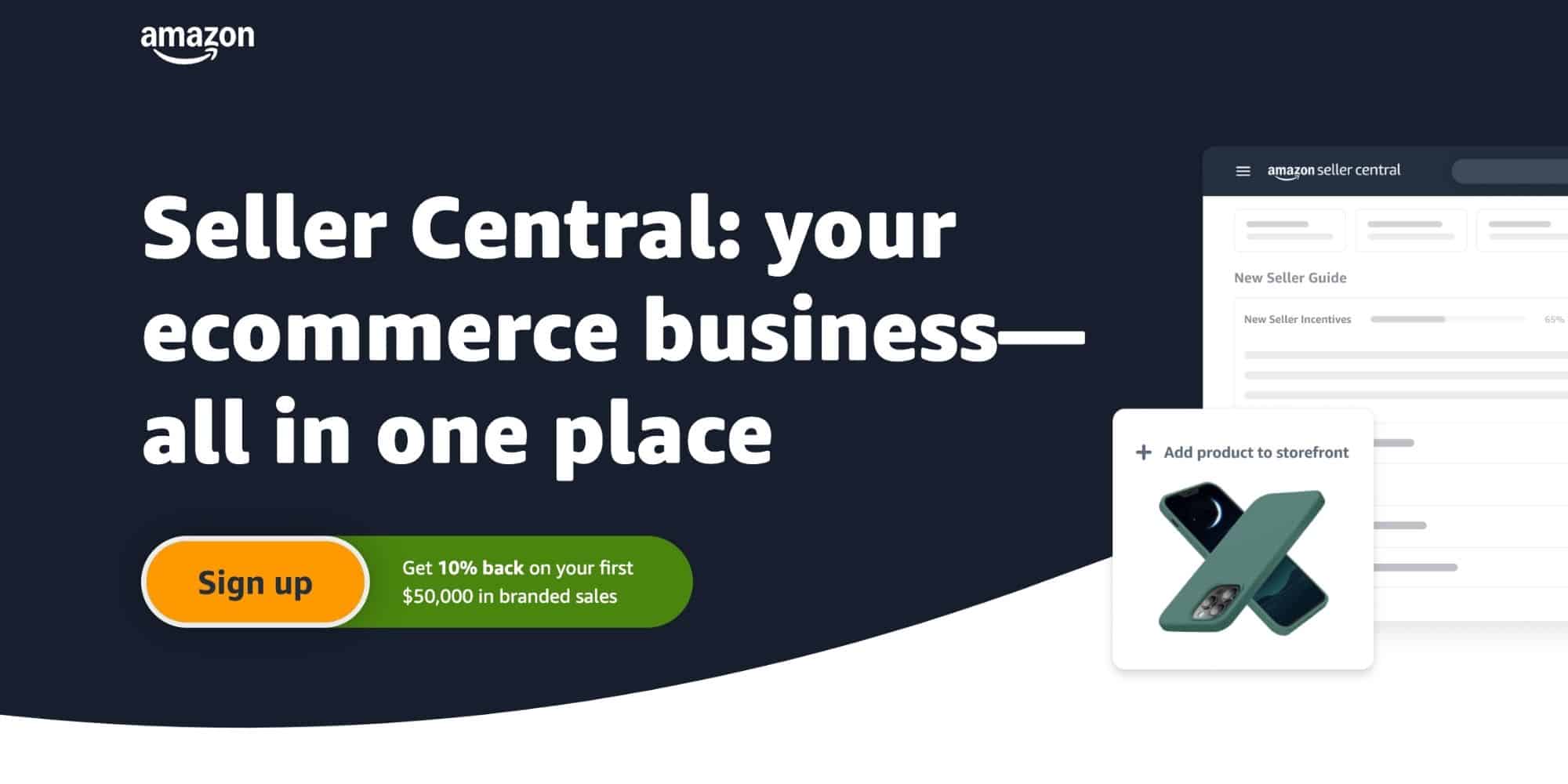
Fulfillment by Amazon (FBA) is a service most associated with selling on Amazon’s marketplace, but it’s also a powerful option for Shopify store owners through Amazon’s Multi-Channel Fulfillment (MCF) program. Essentially, you can leverage Amazon’s vast fulfillment network – over 110 U.S. fulfillment centers and many more globally – to store and ship orders for your Shopify customers. The draw here is Amazon Prime-level speed and reliability: inventory in FBA can often reach customers in 1-2 days, and Amazon handles the heavy lifting of logistics and even customer service in some cases.
|
Amazon FBA (via MCF) |
Details |
|
Best for |
Established Shopify sellers who want world-class logistics and global reach, or those who already sell on Amazon and want to unify inventory. Great for fast-moving consumer goods where Amazon’s network can deliver speed. Also useful if you want Prime-like shipping speeds on your Shopify store to boost conversion. |
|
Pricing |
$$ – Complex fee structure. Rough ballpark: Storage ~$0.75–$2 per cubic foot per month (varies by season); Fulfillment fee ~$3–$8 for small/medium items (more for heavy/bulky). $39.99/mo seller account fee. Additional fees for long-term storage (after 365 days) and optional services (e.g., FBA label service). Amazon’s sheer volume often means lower shipping rates per package, but watch out for accumulating fees. |
|
Speed & Service |
Prime-speed shipping, often 1-3 days nationwide. Amazon handles customer service for delivery issues and processes returns efficiently. However, shipments arrive in Amazon-branded packaging (your Shopify customers may receive a box with an Amazon logo). You sacrifice some brand presentation and control over carrier selection in exchange for reliability. |
|
Integration with Shopify |
Achieved via Amazon MCF app or third-party integrations. Orders from Shopify can be automatically sent to FBA for fulfillment. The integration setup is a bit more involved than a typical 3PL app, but once running, it’s fairly seamless. Tracking numbers are returned to Shopify. Keep in mind you must manage inventory through Amazon’s Seller Central, separate from Shopify, since you’re essentially an Amazon seller using FBA. |
|
Special Considerations |
– Product Prep: Must comply with Amazon’s prep and labeling requirements (could mean extra prep work or paying Amazon’s prep fees). – No Customization: No special inserts or branding (everything is packed “Amazon-style”). – Multi-Channel Fees: Using FBA for non-Amazon orders has slightly different fees (MCF orders may cost a bit more than Amazon marketplace orders). – Scalability: Virtually unlimited – can handle huge volumes and peak seasons, but plan inventory carefully to avoid storage penalties. |
Why use FBA for Shopify: In short, speed and reach. With FBA, you can promise customers extremely fast delivery, often rivaling Amazon Prime, which can increase conversion rates on your Shopify site. You also gain the ability to expand sales internationally without having to find new warehouses – just send stock to Amazon’s facilities in target countries and let them handle local fulfillment. For many businesses, FBA’s reliability (they invest heavily in automation and error reduction) means fewer fulfillment headaches – orders go out on time, and you don’t have to micro-manage the process. It’s also convenient if you’re already selling on Amazon; you can use one pool of inventory to serve both Amazon and Shopify orders, which simplifies stock management.
Downsides: Branding and control are the main sacrifices. Your Shopify customers might be surprised to get an Amazon box, which could dilute your brand identity (and even potentially steer them toward Amazon in the future). Also, Amazon’s policies and fee changes are outside your control – you’re playing in their system, which sometimes changes rules (e.g., restock limits). Higher fees for certain scenarios are another issue: if you have slow-selling items, FBA’s storage fees will bite, and if your products are large or heavy, FBA can get very expensive. Lastly, setup and management complexity: you have to maintain an Amazon seller account and make sure Shopify and Amazon inventories stay aligned. It’s not as plug-and-play as a normal 3PL integration initially. However, many merchants find the pros outweigh these cons if rapid fulfillment and worldwide reach are key to their strategy.
7. ShipNetwork (formerly Rakuten Super Logistics)
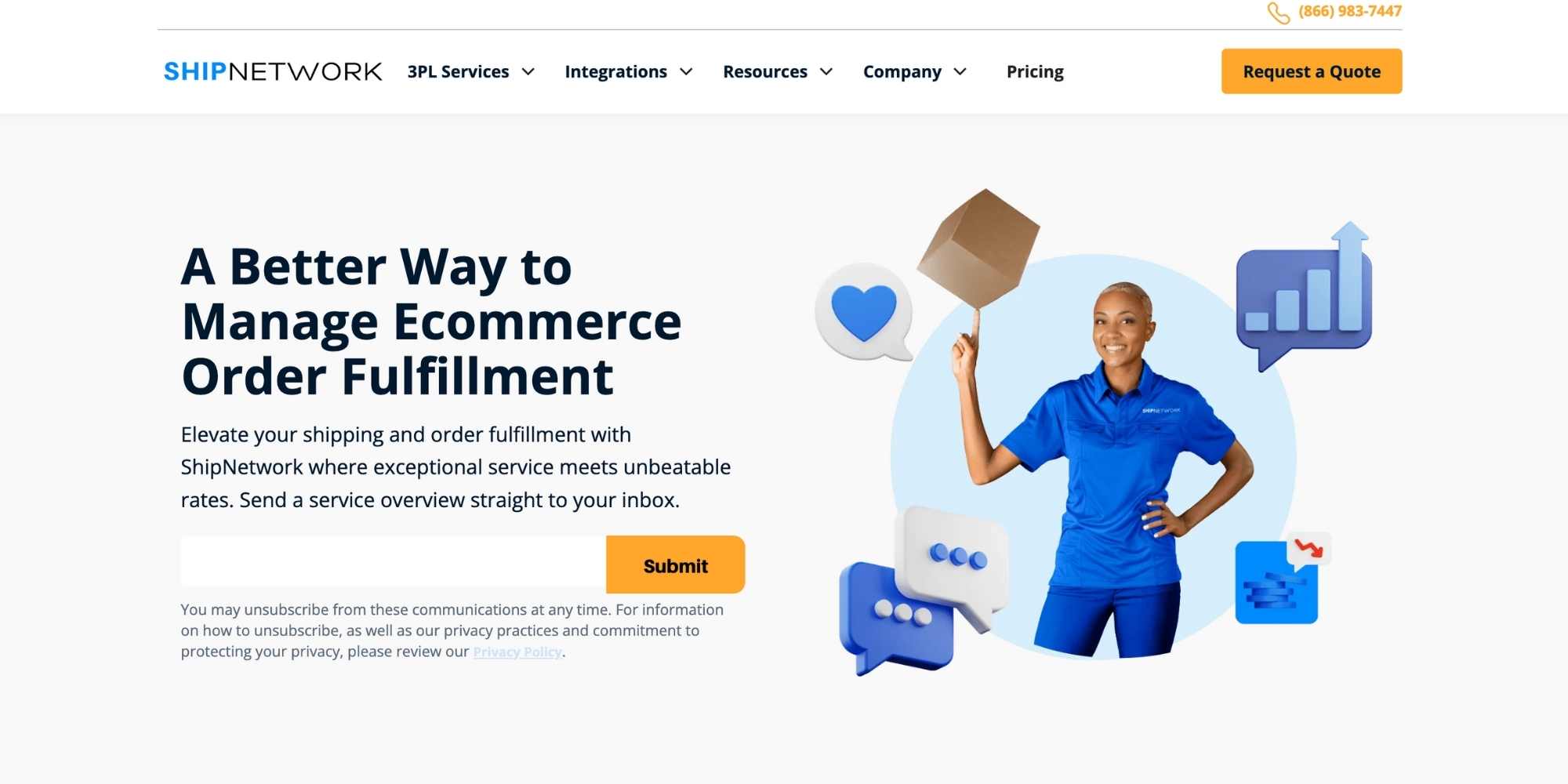
ShipNetwork, which many eCommerce veterans might know by its old name Rakuten Super Logistics (RSL), is a 3PL that emphasizes speed and scalability through a nationwide network. With roots dating back to Webgistix (acquired by Rakuten), and now under new ownership as ShipNetwork, this provider offers 1-2 day ground shipping coverage across the entire continental U.S. by leveraging multiple fulfillment centers. They focus on eCommerce fulfillment and have a range of services that appeal to growing Shopify stores, including some unique offerings like their Xparcel shipping service for cost-optimized deliveries.
|
ShipNetwork (RSL) |
Details |
|
Best for |
Shopify stores that need fast 1-2 day shipping across the U.S. and plan to scale rapidly. Ideal for businesses that want to offer Amazon Prime-level delivery speeds with a 3PL partner. Also great for those needing kitting (product bundling) or running subscription box models, given the tailored services for those. |
|
Pricing |
$$ – Moderate, with no strict minimums. Pricing is quote-based: storage fees depend on pallet/bin usage, fulfillment fees on order complexity. They highlight no required monthly order minimum. Shipping costs are optimized via their Xparcel multi-carrier system (often saving money while hitting 2-day targets). Expect standard 3PL rates overall, with possible savings on shipping and the cost-benefit of fewer errors (they guarantee accuracy). |
|
Network Strength |
Nationwide 1-2 Day Delivery: Multi-warehouse network ensures ground delivery reaches any U.S. address quickly. They guarantee orders go out next-day (if not same-day). Particularly strong if your customers are widely dispersed across the country. |
|
Services & Features |
– Xparcel Shipping: Smart routing of packages through various carriers for best speed vs. cost mix. – Advanced Kitting: They can bundle items into kits (e.g., creating new SKU sets) efficiently. Good for flash sales or gift sets. – Subscription Box Fulfillment: Yes, experienced in handling subscription businesses, ensuring monthly orders are assembled correctly. – Tech Integration: Shopify integration is straightforward; their SmartFill platform gives you inventory visibility and control. – Returns Management: Streamlined processing to inspect and restock returns, with reporting on return reasons. |
Why ShipNetwork is compelling: The promise of fast nationwide shipping without managing dozens of individual 3PL contracts is a big draw. ShipNetwork essentially lets you have a distributed warehouse strategy through one partner. For Shopify sellers competing on delivery time, this is crucial.
They also have longevity in the industry (as RSL) and have served a lot of direct-to-consumer brands, so they’ve encountered and solved many logistic challenges. The accuracy and next-day-out guarantees provide peace of mind that orders won’t languish or go out wrong, which can protect your store’s reputation. Also, the breadth of services like kitting and subscription handling means you can keep using them as your business diversifies (you won’t outgrow their capabilities quickly).
Points to consider: While having many warehouses is beneficial for speed, it does mean you will be splitting inventory – you’ll need to keep track of stock levels across locations and invest in more inventory upfront to populate multiple warehouses.
ShipNetwork’s software helps with that, but it’s something to be aware of (this is true for any multi-node fulfillment strategy). Also, their rebranding and ownership change is recent (Rakuten sold it), but early indications are that it’s positive, with investments in technology and customer service. It’s always wise to check recent reviews, but overall they have a solid track record.
8. Whiplash (Ryder E-commerce)
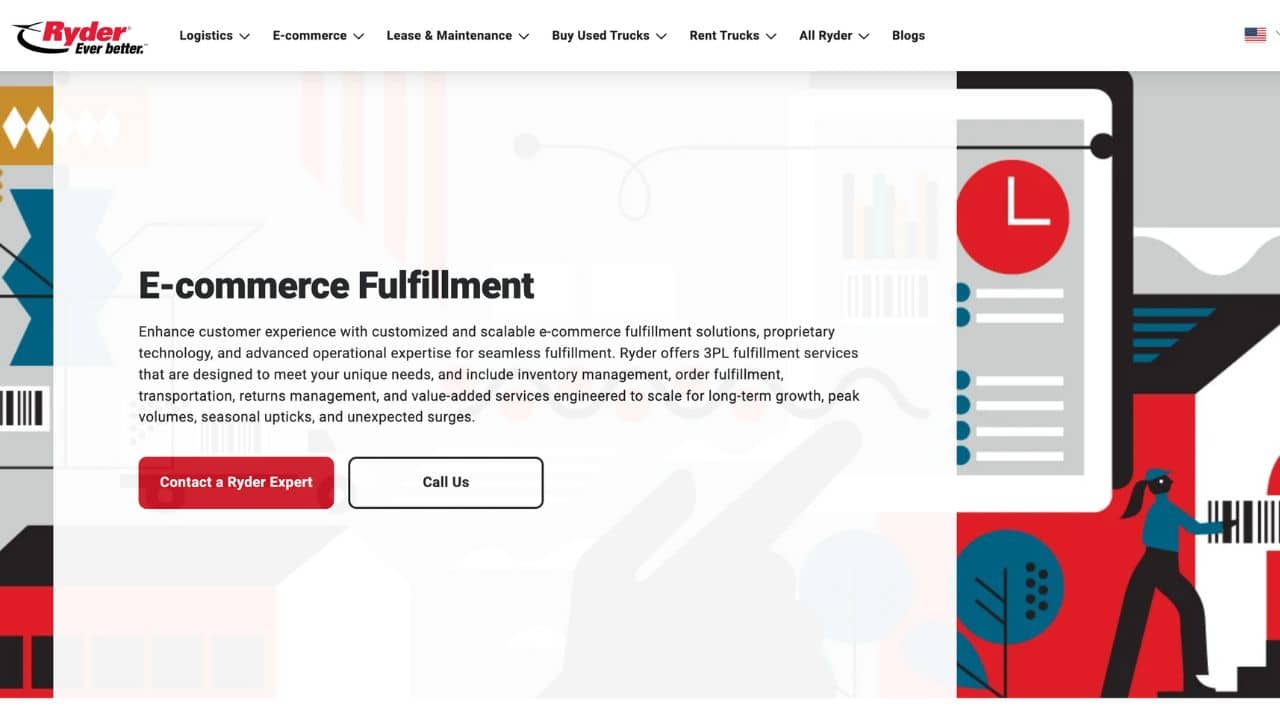
Whiplash – now known as Ryder E-commerce by Whiplash after being acquired by logistics giant Ryder – is a fulfillment provider that shines when it comes to tailored solutions and omnichannel support. Whiplash built its reputation working with lifestyle and fashion brands that demand a high degree of branding and flexibility in fulfillment (think curated unboxing experiences, handling of both D2C and retail/wholesale orders, etc.). If your Shopify store requires a fulfillment partner that can adapt to unique processes or integrate special technology, Whiplash is a top contender.
|
Whiplash Fulfillment |
Details |
|
Best for |
Shopify brands that require highly customized fulfillment workflows or serve multiple channels (D2C, B2B, retail). Particularly popular with lifestyle, fashion, and subscription-based brands that want to maintain a unique unboxing experience and need a partner to grow with their complex needs. If you value flexibility and a tailor-made approach, Whiplash is ideal. |
|
Pricing |
$$$ – Custom pricing based on services. Generally higher than basic 3PLs due to the personalized services. No standard setup fee; integration with Shopify is free and straightforward. Costs for storage and basic fulfillment are competitive, but adding things like special packaging, assembly, or omnichannel features will increase the cost. Suitable for medium to large operations; small sellers can use it too, but should ensure the value-add justifies the cost. |
|
Key Features |
– Custom Fulfillment Solutions: They adapt to your processes (e.g., specific packing rules, custom QC, unique insert per order types). – Omnichannel & B2B: Can handle wholesale orders, retail distribution, and dropshipping to stores along with Shopify consumer orders, all from the same inventory pool. – Technology: Advanced platform with real-time tracking, and can integrate beyond Shopify (ERP systems, EDI for big-box retailers, etc.) to centralize operations. – Scalability: Backed by Ryder, meaning if you suddenly need freight services or more warehouses, they can accommodate. They offer strategic guidance for scaling fulfillment as you grow. |
|
Warehouse Network |
18+ warehouses in the US, plus international sites or partners (Canada, UK, and more). Strong presence on both coasts (especially CA and NJ/NY) to enable 2-day shipping nationwide. You can use one or multiple locations as needed. The network is continually expanding under Ryder. All locations use the same Whiplash system for consistency. |
Why Whiplash appeals to Shopify merchants: In the crowded 3PL market, Whiplash stands out by saying “yes, we can do that” to things many others might not. For a Shopify merchant, that means you don’t have to conform to a one-size-fits-all approach. Instead, Whiplash will help design a fulfillment experience that mirrors your brand.
For example, if your brand has a signature way of wrapping products in tissue with a seal and including a handwritten card, Whiplash can train staff to do exactly that for each order. If you need to integrate your inventory system or manage a mix of direct consumer orders and bulk wholesale shipments, Whiplash’s systems and team can handle it under one roof. This ability to unify D2C and B2B is increasingly important as brands diversify channels.
Things to note: The trade-off for all this flexibility is that Whiplash may not be the absolute cheapest option. If your fulfillment needs are very straightforward, you might find a cheaper provider. Also, with such a customizable approach, it’s important to communicate clearly and manage the partnership – essentially, you become a bit more collaborative with Whiplash in designing processes.
This is great if you want that involvement, but if you prefer a plug-and-play solution with minimal oversight, a more rigid 3PL might suit you better. Whiplash’s size (being part of Ryder) means you get stability and resources, but it’s also not a small boutique – ensure you establish a good line of communication with your account managers to get the personalized attention you need (they are generally known to be good at support). In summary, Whiplash is a top choice for Shopify Plus level merchants or any seller who sees fulfillment as an extension of their brand, not just a commodity logistics function.
9. Fulfillrite
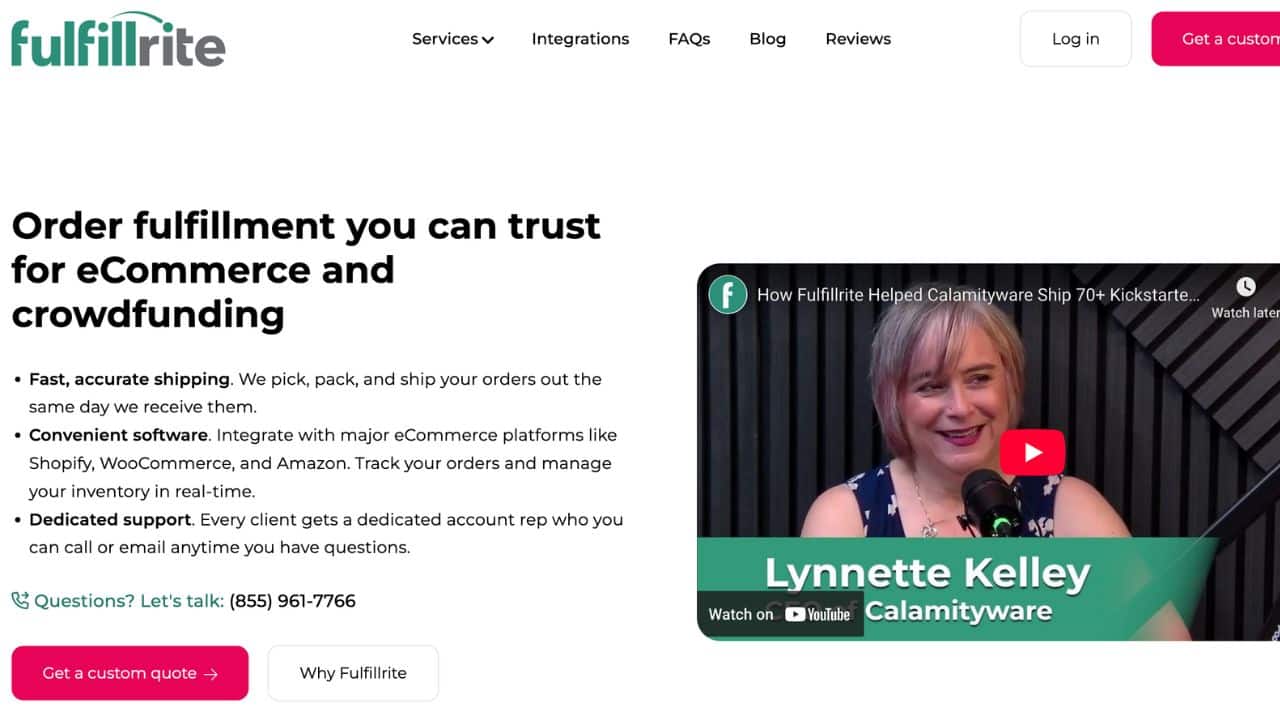
Fulfillrite is a boutique fulfillment company based in New Jersey, USA, that has made a name for itself especially among small businesses. They offer a very hands-on, personalized service and specialize in fulfilling crowdfunding rewards, subscription boxes, and other small-batch orders with high accuracy. If your Shopify store is just starting out or you run limited releases / campaigns, Fulfillrite could be an excellent partner.
|
Fulfillrite |
Details |
|
Best for |
Crowdfunders, startups, and small Shopify sellers who need a reliable yet affordable fulfillment partner. Also excellent for subscription box companies and anyone who ships smaller volumes or batches (like an artist releasing products in drops). If you value personal support and not being “lost” among big clients, Fulfillrite is ideal. |
|
Pricing |
$ – Budget-friendly, transparent pricing. No setup fees, no monthly minimums. Fulfillment fees start at $2.50 per order (plus postage). Storage billed per bin/pallet at reasonable rates. Great for keeping costs low when order volume is modest. You only pay for what you use. |
|
Key Strengths |
– Crowdfunding Fulfillment: They have a proven track record with Kickstarter/Indiegogo projects, managing bulk reward shipments and surveys expertly. – Accuracy and Speed: Very high accuracy and typically ships orders within 1 business day of receiving them. Many small businesses report improved customer satisfaction after moving to Fulfillrite. – Customer Service: Hands-on support. You can talk to a fulfillment specialist easily. They’ll even proactively reach out if they see something amiss (e.g., an address issue or inventory running low). – Integration: Simple Shopify integration, plus works with BackerKit and other pledge managers for crowdfunding. Real-time order and tracking updates back to Shopify. |
|
Limitations |
Single warehouse (NJ, USA) – fine for most, but not a distributed network. If ultrafast delivery nationwide or multiple int’l warehouses are needed, they’re not multi-location. They focus on small to mid-sized product dimensions; they can handle some larger items, but if you sell very large/heavy goods, other 3PLs might suit better. |
Why Fulfillrite gets love from small businesses: They understand the needs of growing brands. For a Shopify store just starting, outsourcing fulfillment can be intimidating, and many 3PLs either turn you away or hit you with high minimum costs. Fulfillrite, on the other hand, welcomes smaller clients and treats their business with importance.
Their motto could well be “no shipment is too small.” The trust they’ve built in the crowdfunding community (which is very vocal about vendors) speaks volumes: many creators have reported that Fulfillrite helped them navigate their first-ever experience shipping hundreds or thousands of packages, making it smooth and error-free. That kind of guidance is invaluable if you’ve never done large-scale fulfillment before.
Keep in mind: With only one warehouse, shipping speed will depend on your proximity to NJ. East Coast U.S. customers will often get packages very quickly, Midwest in a moderate time, West Coast in ~4-5 days via standard ground. If your store’s value proposition is 2-day delivery everywhere, Fulfillrite’s model might fall short unless you upgrade shipping methods (which cost more). Also, they don’t have the huge network or extra services like some others – for example, they won’t be doing complex freight forwarding or international warehousing.
But for 99% of small businesses, those are not concerns. If down the line you become a nationwide brand needing multiple nodes, you might re-evaluate, but Fulfillrite is actually capable of handling surprisingly large volumes out of one location (especially if your customers are mainly U.S./Canada and you don’t mind 3-5 day transit). In summary, Fulfillrite is a gem for those early and growth stages, giving you expert fulfillment without breaking the bank.
10. Simpl Fulfillment
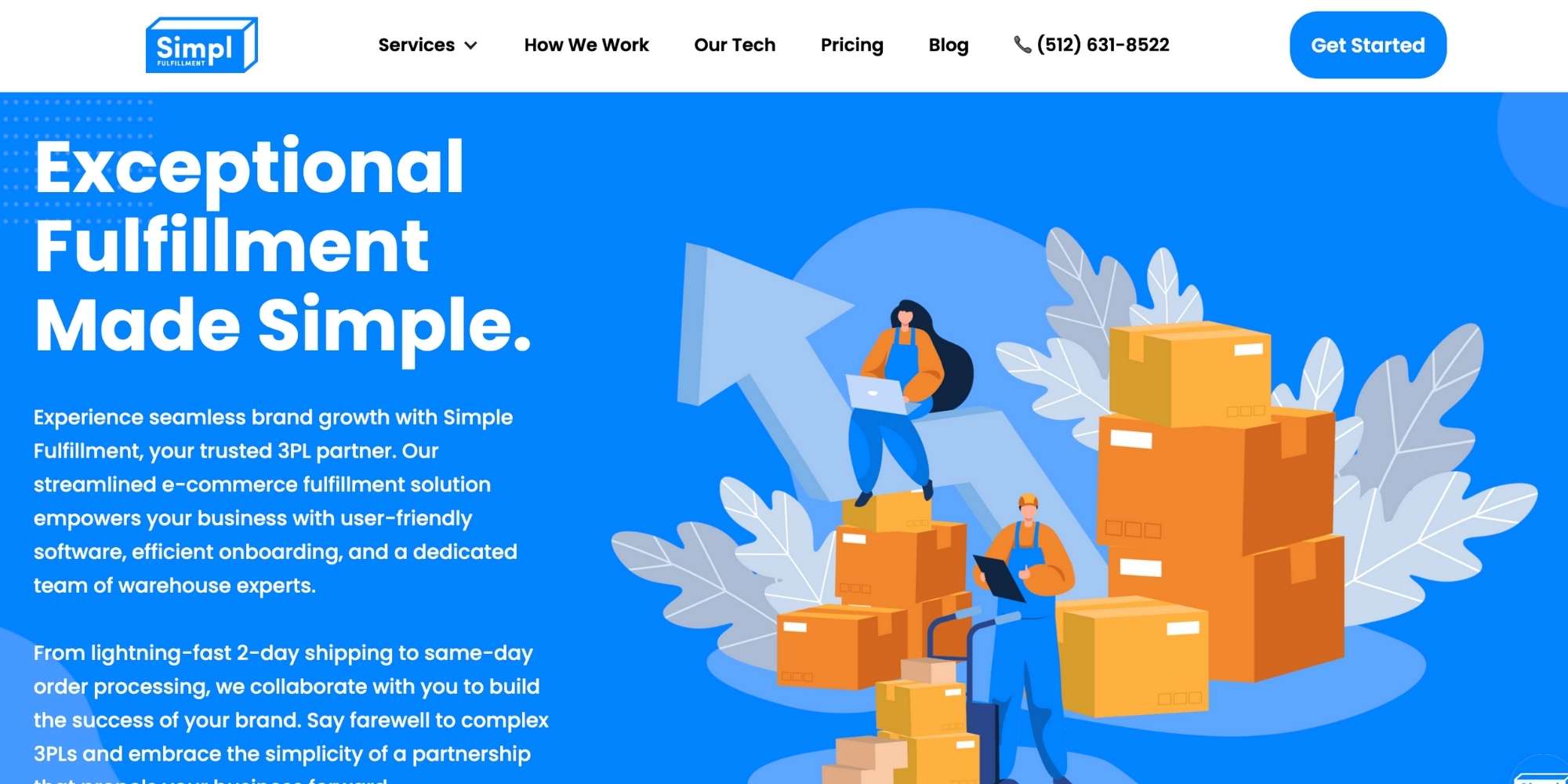
Simpl Fulfillment (not a typo – it’s “Simpl” without the second “e”) is a Texas-based 3PL that prides itself on straightforward, all-inclusive pricing and ease of use for small-to-medium eCommerce businesses. They market themselves as a no-nonsense solution where you pay a flat fee per order which already includes standard postage and handling, simplifying cost calculations tremendously. For Shopify sellers who hate surprise fees and complicated bills, Simpl Fulfillment is an attractive option.
|
Simpl Fulfillment |
Details |
|
Best for |
Shopify sellers (especially startups and SMBs) who want predictable, transparent fulfillment costs and an easy-to-understand service. If you’re tired of complicated invoices with various fees, Simpl’s flat-rate model will appeal. It’s also great for those on a budget – you can essentially “set and forget” your fulfillment costs per order which helps with financial planning. |
|
Pricing |
$ – Flat-rate, all-inclusive pricing per order. E.g., around $2.85 per order for lightweight packages (higher for heavier). This includes picking, packing, packaging, and shipping costs for that order – virtually everything. Minimal extra fees; storage fees apply but are straightforward. No setup or hidden fees. It’s very startup-friendly and you pay exactly in proportion to your sales. |
|
Service Highlights |
– Simplicity: As the name implies, they make fulfillment simple. Easy sign-up, quick integration, and you immediately know your costs. – Custom Packaging: Will use your branded boxes or inserts at no extra charge. This is often an add-on fee elsewhere, so it’s a plus for brand-conscious sellers. – Flexible for Growth: No long-term commitment; as you grow, your cost per order stays the same flat rate for that weight class (you just ship more orders). This avoids surprises when scaling up. – Location: Central U.S. location means decent shipping transit times nationwide. Good if your customer base is geographically diverse. – Support: Given their focus on simplicity, their team is accessible to resolve any confusion. They are likely smaller than giants, meaning you can reach a human who knows your account. |
|
Considerations |
One warehouse (Texas) – fine for most, but not designed for guaranteed 1-2 day delivery to far coasts unless you upgrade shipping. They focus on normal eCommerce parcels; extremely large/heavy items might not fit the flat model. Always ensure your product weights are accurate in their system for the flat-rate calculation. |
Why choose Simpl Fulfillment: For many Shopify entrepreneurs, dealing with fulfillment pricing is a headache – there’s pick fees, pack fees, storage, insert fees, etc. Simpl Fulfillment eliminates that headache by giving you a single combined rate. This not only reduces administrative burden (easier accounting), but it also often ends up being cost-effective. You can offer free shipping or flat shipping to your customers with confidence because your cost is flat. It lowers the barrier to outsourcing fulfillment, because you can immediately answer: “If I outsource, it will cost me $X per order, period.” Additionally, their willingness to do custom touches without add-on fees is great for maintaining brand integrity on a budget.
From a service standpoint, Simpl is somewhat similar to Fulfillrite in catering to smaller sellers, but with a different approach on pricing. They basically say: “We make it simple and we won’t surprise you.” That fosters trust, which is huge when handing over your inventory. The Texas location is a bonus because it’s efficient for shipping in the U.S. If you’re a mid-country 3PL, you minimize extreme shipping times and zones.
A little caution: Always double-check what the flat fee includes. It likely covers standard shipping (probably USPS First Class/Priority or UPS Ground for heavier). If you have special shipping needs (like overnight services or signature confirmation), those might be extra. But for the majority of everyday orders, it’s as advertised. Also, if your products are at the heavier end (say 10-20 lbs each), ensure you see their rate for that, as flat might become more like “flat per weight tier” – which is still fine but just know your brackets. Given their focus on transparency, they’ll happily show you all that.
After reviewing these ten fulfillment services, you can see that each has its strengths. The “best” fulfillment service for a Shopify store ultimately depends on your store’s specific needs – volume, product type, customer locations, and what you value (cost, speed, customization, etc.). Our #1 pick, eFulfillment Service, offers a balanced solution for most merchants with its no-minimum, no-fuss approach and long-standing reliability. However, if you have a particular scenario (like heavy products, or need 2-day shipping, or are a tiny startup), one of the others might fit even better.
10 Additional Honorable Mentions: Shopify-Friendly 3PLs

1. ShipHype
- Key details: Deep Shopify integration, omnichannel support, launch partner for DTC growth; includes FBA prep and custom services.
- Pricing: Starts at $499/mo plus $1/order; API, EDI, ERP integrations incur setup fees ($1K+) and monthly maintenance.
2. AMZ Prep
- Key details: Specializes in Amazon FBA prep but also offers ecommerce support; known for transparent per-unit pricing.
- Pricing: Prep ranges from $0.40–$1.00+ per unit; inbound fees $1.50/carton or $8/pallet, plus per-unit prep services.
3. ShipFusion
- Key details: Boutique 3PL with locations across IL, PA, NV, Toronto; strong in inventory software and custom reporting.
- Pricing: Free to install; custom quotes, shipping savings up to 37%; pick-pack pricing varies (base included, extras per added pick).
4. ZendBox
- Key details: Fast Shopify integration, real-time management via “Zendportal”; supports multi‑channel fulfillment.
- Pricing: Clients typically spend $10K–$50K/mo; suited for mid to high volume due to pricing scale.
5. ShipNetwork
- Key details: Nationwide 24‑unit network, 1-day fulfillment guarantee, intelligent Xparcel carrier selection, full returns management.
- Pricing: Custom quotes; clients save up to 15% on shipping costs, with flexible pricing models (flat‑rate, storage‑based, pay‑per‑order)
6. Flexport (formerly including Deliverr)
- Key details: End-to-end global logistics and ecommerce fulfillment, scalable for international selling, tightly integrated with Shopify Fulfillment Network.
- Pricing: Quote‑based; includes storage, handling, and shipping fees; offers a calculator for custom estimates.
7. FreightPros Fulfillment
- Key details: Great for SMBs, offers both LTL/rail and single‐package shipping, strong customer service .
- Pricing: Competitive, volume‑based; ideal for small runs—no minimum order requirement.
8. Ships‑a‑Lot
- Key details: Reliable domestic fulfillment for Shopify merchants, especially via FedEx; single‑warehouse model.
- Pricing: Free onboarding; volume‑based pricing; add-on return fees; transparent, simple fee structure.
9. RedHawk Global
- Key details: Tech-driven logistics, growth‑oriented; includes fulfillment, kitting, and DTC support.
- Pricing: Listed alongside top‐tier providers; pricing competitive but custom—volume & product‑based quotes.
10. WhiteBox
- Key details: Combines marketplace management (Amazon, Walmart) with fulfillment; supports on‑demand kitting and multichannel orders .
- Pricing: Mid‑high tier; custom quotes depending on services—typically includes fulfillment, marketplace integration, and advertising support .
How to Choose the Right Fulfillment Service for Your Shopify Store
Selecting a fulfillment service is a crucial decision that can impact your store’s reputation, customer satisfaction, and bottom line.

Here are key factors and considerations to keep in mind as you evaluate your options:
1. Service Specialization and “Best For” Alignment:
Start by considering the nature of your products and business model. Do you ship large, heavy items or small, lightweight goods? Are you a subscription box service, a crowdfunding campaign, or a high-volume retailer? Look for a fulfillment provider that specializes in or has a strong track record with your specific needs. For example, if you run a Kickstarter project or small batch business, a provider like Fulfillrite that is geared toward small businesses and crowdfunding would be a better fit than a huge 3PL focused on enterprise clients.
2. Pricing Structure and Transparency:
Fulfillment costs can be complex, so clarity is key. Determine if a provider’s pricing model suits you – do they charge a la carte fees (pick, pack, storage, etc.) or a simplified flat rate? Ensure you understand all potential fees: receiving, long-term storage, account management, etc. Ideally, opt for a service with transparent pricing where you can easily calculate your cost per order.
For instance, some fulfillment center’s flat-rate model may appeal if you want predictable costs per shipment, whereas others might offer volume discounts that benefit you as you scale. Beware of quotes that seem “too good to be true” – they might not include all add-ons (e.g. custom packaging fees or surcharges). Always ask for a detailed breakdown of what’s included in the fees to avoid surprises.

3. Warehouse Locations and Shipping Speed:
The location of fulfillment centers directly affects shipping times and costs to your customers. If your customers are nationwide across the U.S., a multi-location 3PL (or one centrally located like in Texas) can reduce transit times. For example, a nationwide network enables 1-2 day ground delivery to most regions.
On the other hand, a single-location provider (like one in New Jersey or Michigan) might mean longer transit to some areas, but could be perfectly fine if most of your customers are on one coast or if 3-5 day shipping is acceptable. Consider where your customer base is concentrated: if 50%+ are in one region, a warehouse in that region (or at least centrally located) is beneficial.
If you plan to expand internationally, you might favor providers with global warehouses or strong cross-border shipping experience (e.g., Amazon FBA for global reach or Whiplash with international partners).
4. Integration with Shopify and Tech Features:
A good fulfillment service should seamlessly integrate with your Shopify store – this includes pulling orders automatically and pushing tracking info back to customers. All the providers on our list integrate with Shopify, but the depth and ease can vary.
Check if the 3PL has a Shopify App or API integration that’s proven. Also, consider the software interface: does it provide useful features like real-time inventory updates, the ability to hold/release orders, manage bundles, and generate reports?
For multi-channel sellers, look for support of other platforms (Amazon, Walmart, Etsy, etc.) within one dashboard. Additionally, find out if you’ll get alerts for low inventory, or if you can manually create orders (useful for phone orders or giveaways). A strong tech platform saves you time and reduces errors via automation.
5. Additional Services and Flexibility:
Beyond plain pick-and-pack, think about any extra services you might need now or in the future. This includes kitting (combining multiple SKUs in one order), assembly, special packaging or gift wrapping, insert marketing materials, lot/batch tracking (important for perishable or regulated goods), and returns processing.
Not all fulfillment centers handle these the same way. If you run a subscription box, ensure the 3PL can pre-assemble kits and handle a surge on shipping day. If branding is important, confirm they allow custom boxes and will follow your packaging instructions.
Some providers excel at customization, whereas others have a more standardized operation. Choose one that can accommodate your special requests without excessive hassle or cost. Also, if you foresee needing B2B fulfillment (shipping to retail stores or Amazon FBA), verify they offer that service.

6. Scalability and Contract Terms:
Envision where your business will be in 1-3 years. You want a fulfillment partner that can scale with you. Evaluate if there are any volume caps or if the provider has clients much larger than you (a good sign they can handle growth). For example, some providers explicitly handle both small and large volumes (eFulfillment Service has no order minimums but also supports high-volume sellers).
Ask about their process if your order volume doubles – can they smoothly ramp up? Additionally, consider contract flexibility: many 3PLs operate month-to-month, but some might push for longer terms. If you’re uncertain, avoid getting locked into a long contract with heavy penalties. It’s often best to start with a shorter term or a trial period.
Pick a long-term partner, not just a vendor: ideally, the 3PL should act as an extension of your business and be willing to grow together.
7. Reliability and Accuracy:
Speed is great, but accuracy and reliability are paramount – a late or wrong order harms customer trust. Look for providers with high accuracy rates or guarantees (e.g., ShipNetwork’s 100% accuracy guarantee or Red Stag’s pledge to secure and correctly ship every order).
Check reviews or ask for references regarding their fulfillment accuracy and how they handle mistakes. Do they have a process to quickly fix errors and compensate if necessary? A slightly more expensive 3PL that’s highly reliable can save money in the long run (fewer reshipments and customer service issues).
Reliability also covers inventory management – you want a partner that maintains 98-99%+ inventory accuracy and conducts regular cycle counts so you don’t oversell due to stock discrepancies. Consider performing a small test run with the provider (if feasible) to gauge their service before moving all your inventory.
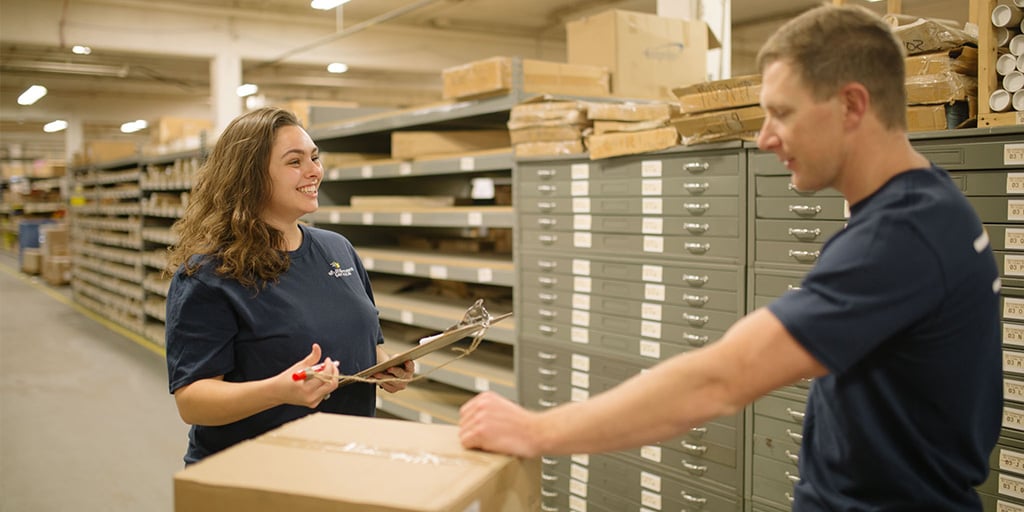
8. Customer Support and Communication:
Inevitably, you’ll need to communicate with the fulfillment center – whether it’s for an inventory delivery, a special order, or troubleshooting. Evaluate how responsive and helpful their support is.
Do you get a dedicated account manager or just a support ticket system? During onboarding, note their attentiveness in answering questions. You might also consider time zone and hours of operation – if you often need help after hours, ensure someone can assist.
Quality of support can vary widely: smaller services like Fulfillrite or Simpl Fulfillment often give very personalized support, while larger ones might have more structured (but still effective) support teams. Decide what level of hand-holding you might need, especially early on, and pick accordingly.
Quick, clear communication from your 3PL can be a lifesaver when an issue arises (for example, receiving a damaged pallet of your goods – you’d want immediate notification and photos).
9. Reviews and Reputation:
Finally, do some homework on each candidate’s reputation. Look up client reviews or case studies. Communities (like Shopify forums or subreddits) often have discussions on fulfillment experiences. Keep in mind one or two bad reviews might not paint the whole picture, but patterns matter.
Is the 3PL known for delays? Do multiple people praise their tech but complain about customer service (or vice versa)? Since you are entrusting them with a core part of your business, some due diligence goes a long way.
A provider with a proven history (e.g., eFulfillment’s 20+ years in business or ShipBob’s industry awards) can offer peace of mind. However, don’t dismiss newer services if they have innovative offerings – just vet their stability and make sure they have contingency plans for common issues (like seasonal spikes or carrier problems).
FAQs: Best Fulfillment Services for Shopify
What does a fulfillment service do for a Shopify store?
A fulfillment service (often a 3PL – third-party logistics provider) handles the storage, packing, and shipping of your orders on your behalf. Essentially, you send your inventory to their warehouse, and when a customer places an order on your Shopify store, the fulfillment service will pick the items, pack them securely, and ship the order to the customer.
They also usually provide tracking information and can manage returns. This offloads the entire logistics process from you, the merchant. Instead of you keeping stock in your home or office and making trips to the post office, the 3PL houses your products in their facility (or multiple facilities), and because they specialize in logistics, they can often do it faster and sometimes cheaper (through bulk shipping rates).
In short, a fulfillment service lets Shopify sellers outsource the operational side of order delivery, ensuring orders are stored, processed, and shipped efficiently by logistics professionals.
How do I integrate a 3PL fulfillment service with my Shopify store?
Integrating a fulfillment service with Shopify is usually straightforward, as most modern 3PLs have ready-to-use integrations. The typical process is: you install the 3PL’s Shopify app or connect via API, and then authorize it to access your store’s data (orders, inventory, etc.). Once connected, when an order is placed, Shopify will automatically send the order details to the fulfillment service.
The 3PL will fulfill the order and then send the tracking number/status back to your Shopify store, which triggers the shipping confirmation to your customer. Some 3PLs might give you a dashboard to monitor orders in real-time as they process. Key integration points to verify:
- Inventory syncing: When the 3PL receives or ships items, your Shopify inventory should update.
- Order cut-off times: Know by what time orders sync each day for same-day shipping.
- Shipping options mapping: Ensure the shipping methods you offer (Standard, Express, etc.) map correctly to the services the 3PL will use.
Most top fulfillment providers (like those listed) have built Shopify-specific integrations or apps, making this mostly a plug-and-play process. During setup, the 3PL’s support team often helps ensure everything is configured correctly. After setup, you can largely let it run automatically: orders flow to the 3PL, and tracking flows back without manual intervention.
How much does outsourcing fulfillment cost (and is it worth it)?
The cost of outsourcing fulfillment varies depending on the provider and your order characteristics, but common fees include:
- Receiving fee: The cost to intake and stock your inventory (some charge per pallet or per hour of receiving).
- Storage fee: Monthly charge for storing your products, often per bin, shelf, or pallet usedshopify.comshopify.com.
- Pick/Pack fee: The labor cost to pick items for an order and pack them (could be a flat per order or per item fee).
- Shipping/postage fee: The cost of the shipping label to send the package to your customer (sometimes 3PLs pass this at cost, other times with a small markup).
- Packaging materials: Some include basic packing materials in the pick/pack fee, others might charge separately.
- Account management or Software fees: A few have monthly fees for using their platform (many don’t).
- Returns handling fee: If they process returns, there’s often a small fee per return.
For example, a typical breakdown might be: $0.30 per item picked, $1.80 per order packed, $0.50 for the box, plus actual postage. So an order with 2 items might cost around $3 + postage. Some like Simpl Fulfillment roll most of these into one flat fee.
Is it worth it? If your order volume has grown to the point where fulfilling in-house is consuming too much time or leading to delays, then yes – outsourcing can save you time to focus on growth and ensure professional delivery.
3PLs can often negotiate better shipping rates (due to volume) than individual merchants, potentially saving on postage. They also have the infrastructure to scale during peak seasons (no need for you to hire temporary staff or beg friends to help pack holiday orders).
The key is to do a cost comparison: calculate your current fulfillment cost (include your time, packing supplies, rent if applicable, etc.), then compare it to quotes from a 3PL. Many find that after a certain point (often around 100–200 orders per month), outsourcing is financially and operationally beneficial. Additionally, with a 3PL, you can potentially offer faster shipping options (like 2-day) at reasonable cost, which can boost sales.
One thing to watch: very low-margin products might struggle with 3PL fees, so do ensure your product pricing factors in fulfillment. But overall, if you choose the right partner, outsourcing can reduce errors, speed up shipping, and free your bandwidth, which usually outweighs the fees.
When should I consider outsourcing to a fulfillment center instead of doing it myself?
There are a few telltale signs that it’s time to outsource:
- Order volume has grown beyond your capacity: If you’re shipping, say, more than 10–20 orders per day and find yourself spending all evening packing boxesshopify.com, it might be time. Ask if your time could be better spent on marketing or product development rather than logistics. As Shopify’s guide suggests, fulfilling over 10-20 orders daily is a good point to evaluate 3PLsshopify.com.
- Space constraints: If inventory is taking over your living room/garage and you’re running out of storage space (or incurring high storage costs), a 3PL’s warehouse can relieve thatshopify.com.
- In-house costs rising: Calculate your current costs – if renting storage or hiring help is becoming expensive, a 3PL might consolidate those costs more efficiently. Don’t forget to factor the “opportunity cost” of your own time.
- Shipping delays or errors are increasing: If customers are complaining about slow shipments or you find yourself making mistakes due to juggling too much, professional fulfillment can improve reliability.
- You want to offer faster shipping or improve customer reach: A single location home operation might not cut it if you want 2-day delivery to the whole country (you’d need multiple warehouses or very expensive shipping). A networked 3PL enables that. Also, if you want to expand overseas, using a fulfillment service with international capabilities can ease entry.
- Seasonal spikes are hard to handle: If you have big surges (holidays, etc.) that strain your DIY setup, a 3PL is equipped to scale labor and processing temporarily for you.
In essence, if fulfilling orders is becoming a bottleneck to your business growth or quality of life, it’s a strong indicator to outsourceshopify.comshopify.com. Many merchants hand off fulfillment once they hit a threshold where their daily orders consume more hours than they can allocate, or when the complexity (multiple SKUs, lots of bundles) introduces too much chance for error.
Can I use Amazon FBA to fulfill my Shopify orders (Multi-Channel Fulfillment)?
Amazon’s fulfillment service isn’t limited to Amazon marketplace orders. Through Multi-Channel Fulfillment (MCF), Amazon FBA will store and ship orders for your Shopify (and other platform) sales. Essentially, you send inventory to Amazon’s FBA warehouses just like you would if selling on Amazon.
Then, when a Shopify order comes in, you can either manually create a fulfillment order in Amazon’s portal or use a Shopify app that integrates with FBA to automatically push the order. Amazon will then pick, pack, and ship it to your customer. The process works and many Shopify sellers use it to leverage Amazon’s incredibly fast shipping network.
However, there are some considerations:
- Branding: Fulfillment by Amazon will ship in Amazon-branded packaging (unless you use a new feature like “plain packaging” for MCF, which at times is available for a fee). So your Shopify customer might receive an Amazon box, which some merchants dislike.
- Fees: Amazon charges slightly different (often higher) fulfillment fees for MCF orders compared to Amazon orders. And you still need an Amazon Pro Seller account (around $39/month) to use FBA, even if you primarily sell on Shopify. So factor in those costs.
- Integration: Shopify has built-in integration for Amazon FBA (you can set Amazon as a custom fulfillment service in Shopify settings), or you can use third-party apps to automate the process.
- Inventory syncing: Since Amazon doesn’t know about your Shopify store inherently, you’ll need to ensure inventory levels stay synced. Usually, Shopify can be updated by the FBA integration app when stock changes at Amazon.
- Product eligibility: You can only fulfill products through FBA that meet their requirements (no prohibited items, within size/weight limits, etc.). Also, FBA might not accept certain custom kits unless each kit is barcoded as a sellable unit.
Using FBA for Shopify can give you Prime-like shipping speed and global reach. It’s especially useful if you already sell on Amazon (so stock is there anyway). Many merchants use a hybrid approach: FBA for some items or regions, and another 3PL or in-house for others.
Overall, it’s a viable option – just weigh the loss of some brand control and the fee structure. But if 2-day shipping everywhere and tapping into Amazon’s logistics prowess is important, FBA is a strong fulfillment avenue for Shopify orders.
Do fulfillment services handle returns and customer inquiries related to shipping?
Fulfillment services typically do handle the physical processing of returns, but customer-facing support is usually still on you (unless you’ve arranged a special service). Here’s how it breaks down:
- Returns Processing: If a customer sends a product back, many 3PLs will receive that return at their warehouse. They will inspect it and, depending on your instructions, restock it if it’s in sellable condition or quarantine it if damaged/used. They then update the inventory in the system. Some can also refurbish or dispose of unsellable goods per your policy. There’s usually a small fee per return processed. For example, SFN (Shopify Fulfillment Network) explicitly handles returns for you as part of their service, and ShipNetwork simplifies returns into inventory as well.
- Customer Inquiries (tracking, delays, etc.): Generally, you (the merchant) remain the point of contact for your customers. So if a customer asks “Where’s my order?” or wants to change an address, etc., they contact you, and then you might use the 3PL’s system to get the info or make requests. However, some services go further: Amazon FBA will actually handle customer service for Amazon orders fully, but for Shopify MCF orders, Amazon will not talk to your customer – you still do that. A few 3PLs might offer customer service add-ons, but that’s not common. You should assume customer communication is your responsibility; the 3PL provides the back-end info and actions.
That said, a good 3PL makes this easy by providing you (and sometimes the customer via tracking links) up-to-date information. Many will even proactively notify you of issues (e.g., if an address is undeliverable, or a package is delayed due to a carrier issue) so you can inform the customer. Some of the integrated fulfillment management systems allow you to set up automatic tracking emails (though Shopify already handles that when tracking is entered).
So, while the fulfillment center is the one physically receiving return packages and restocking items (so you don’t have to do that) and they often help with reverse logistics (e.g., they might generate return shipping labels for you to send to customers, billable to your account), you’ll likely still be the one communicating with the customer throughout the process, unless you make other arrangements.
Summary and Key Points
Using these tips you can create a shortlist of fulfillment services that meet your criteria. Take advantage of consultations many offer – get a feel for their service through a sales call. The right fulfillment partner will not only store and ship your products, but also contribute to your brand’s reputation through timely, accurate deliveries and help you keep logistics headaches at bay.
Remember, outsourcing fulfillment should ultimately free up your time to focus on growth, marketing, and product development. By choosing carefully now, you set the stage for smoother operations and happier customers down the line.


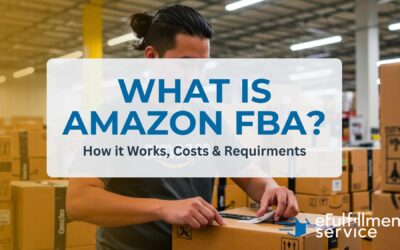

0 Comments